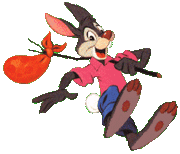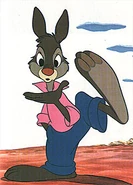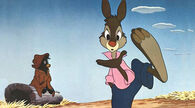No edit summary Tag: Visual edit |
No edit summary |
||
| Line 97: | Line 97: | ||
[[Category:Rivals]] |
[[Category:Rivals]] |
||
[[Category:Roger Rabbit character]] |
[[Category:Roger Rabbit character]] |
||
| + | [[Category:House of Mouse characters]] |
||
[[Category:Aikatsu! characters]] |
[[Category:Aikatsu! characters]] |
||
[[Category:Speedsters]] |
[[Category:Speedsters]] |
||
Revision as of 21:29, 28 July 2019
Br'er Rabbit (also spelled Bre'r Rabbit or Brer Rabbit or Bruh Rabbit, with the title "Br'er" pronounced /ˈbrɛər/) is a central figure in the Uncle Remus stories of the United States. He is a trickster character who succeeds through his wits rather than through strength, tweaking authority figures and bending social mores as he sees fit.
The origin of Br'er Rabbit is linked to both African and Cherokee cultures. Disney later adapted the character for their Song of the South. Disney's Br'er Rabbit appears at Splash Mountain.
African origins
The Br'er Rabbit stories can be traced back to trickster figures in Africa, particularly the hare that figures prominently in the storytelling traditions in Western,Central and Africa. These tales continue to be part of the traditional folklore of numerous peoples throughout those regions. In the Akan traditions of West Africa, the trickster is usually the spider (see Anansi), though the plots of spider tales are often identical to those of stories.
Many have suggested that the American incarnation, Br'er Rabbit, represents the enslaved African who uses his wits to overcome circumstances and to exact revenge on his adversaries, representing the white slave-owners. Though not always successful, his efforts made him a folk hero. However, the trickster is a multi-dimensional character. While he can be a hero, his amoral nature and lack of any positive restraint can make him a villain as well. For both Africans and African Americans, the animal trickster represents an extreme form of behavior which people may be forced to emulate in extreme circumstances in order to survive. The trickster is not to be admired in every situation; he is an example of what to do, but also an example of what not to do. The trickster's behavior can be summed up in the common African proverb: "It's trouble that makes the monkey chew on hot peppers." In other words, sometimes people must use extreme measures in extreme circumstances.
The American version of the story is said to have originated among enslaved Africans. Br'er Rabbit stories were written down by Robert Roosevelt, uncle of President of the United States Theodore Roosevelt. Teddy Roosevelt wrote in his autobiography, about his aunt from Georgia, that "She knew all the 'Br'er Rabbit' stories, and I was brought up on them. One of my uncles, Robert Roosevelt, was much struck with them, and took them down from her dictation, publishing them in Harper's, where they fell flat. This was a good many years before a genius arose who, in 'Uncle Remus', made the stories immortal."
These stories were popularized for the mainstream audience in the late 19th century by Joel Chandler Harris, who wrote up and published many of the stories which were passed down by oral tradition. Harris also attributed the birth name, Riley, to Br'er Rabbit. Joel Chandler Harris heard the tales in Georgia. Very similar versions of the same stories were recorded independently at the same time by folklorist Alcée Fortier in southern Louisiana, where the Rabbit character was known as Compair Lapin in Creole French. The stories were retold for children by Enid Blyton, the English children's writer.
The word "Br'er" in his name (and in those of other characters in the stories) reflects the habit of addressing another man as "brother" in many African cultures. While mainstream Americans generally pronounce the second 'r' in Br'er, the African-American pronunciation is "Bruh" or "Buh." When Joel Chandler Harris spelled "Br'er" with an 'er' at the end of the word, he was indicating the Southern pronunciation of the final 'er' as in "brothuh" (brother), sistuh (sister), or faa'muh (farmer).
Cherokee origins
Although Joel Chandler Harris collected materials for his famous series of books featuring the character Br'er Rabbit in the 1870s, the Br'er Rabbit cycle had been recorded earlier among the Cherokees: The "tar baby" story was printed in an 1845 edition of the Cherokee Advocate the same year Joel Chandler Harris was born.
Rabbit and Hare myths abound among Algonquin Indians in Eastern North America, particularly under the name Nanabozho. The Great Hare is generally regarded as the supreme deity among tribes in eastern Canada.
In the Cherokee tale about the briar patch, "the fox and the wolf throw the trickster rabbit into a thicket from which the rabbit quickly escapes." There was a "melding of the Cherokee rabbit-trickster ... into the culture of African slaves." "In fact, most of the Br'er Rabbit stories originated in Cherokee myths."
Modern interpretations

The Disney Version
- The 1946 Disney film Song of the South is a frame story based on three Br'er Rabbit stories, "The Laughing Place", "The Tar Baby", and "Briar Patch". The character of Br'er Rabbit was voiced by Johnny Lee in the film, and was portrayed as more of a "lovable trickster" than previous tales. Disney comics starring that version of Br'er Rabbit have been done since 1945.
- The Magic Kingdom and Disneyland thrill rides, both known as Splash Mountain, have a Song of the South theme where riders can see Brer Rabbit. Br'er Rabbit also appears at the Walt Disney Parks and Resorts for meet-and-greets, parades and shows. He also has a cameo appearance in Who Framed Roger Rabbit, and appears as one of the guests in House of Mouse. Jess Harnell performed Br'er Rabbit's voice characterizations in Splash Mountain and modern animation.
- A direct-to-video film based on the stories, The Adventures of Brer Rabbit, was released in 2006.
- For many years, a popular brand of molasses called "Brer Rabbit" was distributed by Penick & Ford Ltd. The brand is currently distributed by B&G Foods of New Jersey.
- The 1972 novel Watership Down features the character El-ahrairah, who the author suggests is based on Br'er.
- In 1981, American composer, pop lyricist and musical auteur Van Dyke Parks wrote a Broadway Musical based on the Br'er Rabbit tales. It was offered as a pop album, but never produced.
- The 1998 film Star Trek: Insurrection made a reference to Br'er Rabbit. The region of space where the film takes place is called the Briar Patch. While fighting off enemy ships, Commander William Riker said he was going to "use the Briar Patch the way Br'er Rabbit did..."
- The Philadelphia experimental chamber pop band Br'er is named after Br'er Rabbit.
- In Oakwood theme park there is a ride called Br'er Rabbit's burrow.
- In the popular Hip-Hop band The Flobots, one of Emcees names is Br'er Rabbit.
- Devin the Dude released a song named Briar Patch. A modern view of the story in R&B/Hip-Hop format.
Gallery
| Uncle Remus |
|---|
| Br'er Rabbit • Br'er Fox • Br'er Bear • Tar baby |

